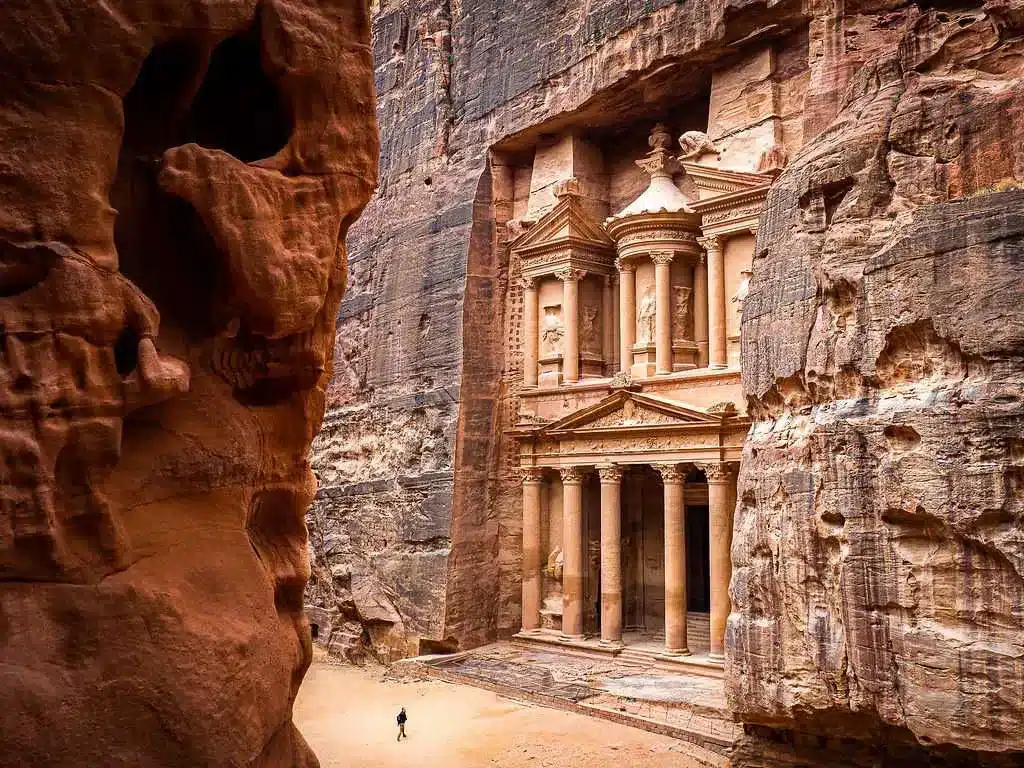About Petra:
- It is a historic and archaeological city located in southern Jordan.
- It was the center of an Arab kingdom in Hellenistic and Roman times.
- Petra was established in 312 AC, which makes it around 2000 years old.
- It became the capital of the Nabateans people, an Arab tribe, who were referred to in the Bible.
- Under Nabataean rule, Petra prospered as a centre of the spice trade that involved such disparate realms as China, Egypt, Greece, and India.
- The Romans conquered Petra in 106 A.C, and they turned the territory into a Roman province of Arabia.
- During the second and third centuries, Petra continued to grow, and in the seventh century, the Romans lost the power of Petra to Islam.
- In the 12th century, Petra was once again taken by different leaders, and for a while, Petra was hidden until it was found by Swiss explorer Johann Ludwig Burckhardt in 1812.
- Features:
- Many of Petra’s buildings were carved directly into rocky sandstone cliffs.
- The name Petra comes from the Greek word for “rock.”
- The city of Petra was built on a terrace with the Wadi Musa (the Valley of Moses) running through it east to west.
- The valley is enclosed by sandstone cliffs veined with shades of red and purple varying to pale yellow.
- Petra is home to roughly 800 tombs, therefore known as the “Royal Tombs”, with the most renowned being ‘The Treasury’.
- To support the ancient city’s large population, its inhabitants maintained an extensive hydrological system, including dams, cisterns, rock-carved water channels, and ceramic pipes.
- Petra has also been referred to as the “Rose City” because of the color of the stones used in its buildings.
- Petra has been a UNESCO World Heritage Site since 1985.
Q1: What is a UNESCO World Heritage Site?
A World Heritage site is a landmark or area with legal protection by an international convention administered by the United Nations Educational, Scientific and Cultural Organisation (UNESCO). World Heritage sites are designated by UNESCO for having cultural, historical, scientific or other forms of significance. The sites are judged to contain “cultural and natural heritage around the world considered to be of outstanding value to humanity (OUV)”.
Source: 2,000-year-old skeletons and ‘Holy Grail’ cup unearthed in secret Petra tomb
Last updated on June, 2025
→ UPSC Notification 2025 was released on 22nd January 2025.
→ UPSC Prelims Result 2025 is out now for the CSE held on 25 May 2025.
→ UPSC Prelims Question Paper 2025 and Unofficial Prelims Answer Key 2025 are available now.
→ UPSC Calendar 2026 is released on 15th May, 2025.
→ The UPSC Vacancy 2025 were released 1129, out of which 979 were for UPSC CSE and remaining 150 are for UPSC IFoS.
→ UPSC Mains 2025 will be conducted on 22nd August 2025.
→ UPSC Prelims 2026 will be conducted on 24th May, 2026 & UPSC Mains 2026 will be conducted on 21st August 2026.
→ The UPSC Selection Process is of 3 stages-Prelims, Mains and Interview.
→ UPSC Result 2024 is released with latest UPSC Marksheet 2024. Check Now!
→ UPSC Toppers List 2024 is released now. Shakti Dubey is UPSC AIR 1 2024 Topper.
→ Also check Best IAS Coaching in Delhi
























